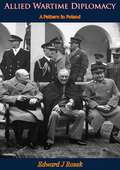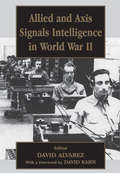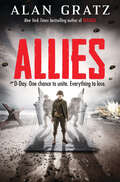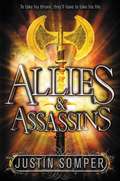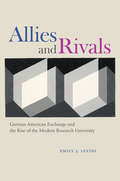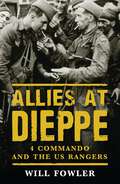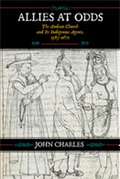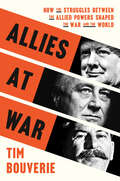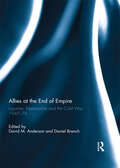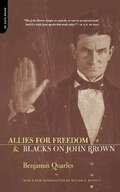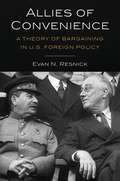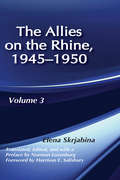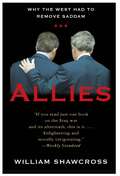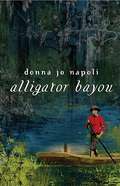- Table View
- List View
Allied Wartime Diplomacy: A Pattern in Poland
by Edward J RozekOriginally published in 1959, this volume is a symposium from Official Government documents, Mikolajczyk's private files and other Polish sources is an indictment of Soviet policy towards Poland and of the Western Allies' leniency towards Stalin.-Print ed.“This study of one of the most important and most neglected aspects of American foreign policy leading up to the concluding phases of the war and the peace settlements might have been called, in a spirit of bitterness, “The Betrayal of Poland.”…It is a prime piece of documentation and analysis for all who would probe the brutal reality of Soviet policy, neither a riddle nor an enigma to those with eyes to see.The story it tells is, of course, written to show the London Polish government’s efforts to win and keep Polish freedom. Taken largely from the indicated Polish sources, set in their proper context, this work sketches the historical background and traces Soviet policy with great insight. But these sources...make available in a form not previously accessible to the student and scholar the twisting and turning of both British and American policy. This policy, taken up at the crucial points of 1939 and 1944 especially, was confronted by the dilemma of how to honor the British commitments to Poland without laying down a direct challenge to the declared intentions of the Soviet Union. These commitments included not only those given at the outbreak of the war in 1939 but the assurances given at the time of the invasion of Poland by the Soviet Union in 1941 that Britain would not recognize “any territorial changes which have been effected in Poland since Aug., 1939.” The puppet “Lublin government” of handpicked and Communist-controlled figures was intended, as the Moscow broadcasts flatly declared, to assure that “the London clique will be wiped out.” By being forced into a coalition with the Lublin government, the London government-in-exile was indeed wiped out, and Mikolajczyk barely escaped with his life.”
Allied and Axis Signals Intelligence in World War II (Studies in Intelligence)
by David AlvarezThe importance of codebreaking and signals intelligence in the diplomacy and military operations of World War II is reflected in this study of the cryptanalysts, not only of the US and Britain, but all the Allies. The codebreaking war was a global conflict in which many countries were active. The contributions reveal that, for the Axis as well as the Allies, success in the signals war often depended upon close collaboration among alliance partners.
Allies
by Alan GratzJune 6, 1944: The Nazis are terrorizing Europe, on their evil quest to conquer the world. The only way to stop them? The biggest, most top-secret operation ever, with the Allied nations coming together to storm German-occupied France. <P><P>Welcome to D-Day.Dee, a young U.S. soldier, is on a boat racing toward the French coast. And Dee -- along with his brothers-in-arms -- is terrified. He feels the weight of World War II on his shoulders. <P><P>But Dee is not alone. Behind enemy lines in France, a girl named Samira works as a spy, trying to sabotage the German army. Meanwhile, paratrooper James leaps from his plane to join a daring midnight raid. And in the thick of battle, Henry, a medic, searches for lives to save. <P><P>In a breathtaking race against time, they all must fight to complete their high-stakes missions. But with betrayals and deadly risks at every turn, can the Allies do what it takes to win? <P><P><b>A New York Times Bestseller</b>
Allies & Assassins (Allies & Assassins #1)
by Justin SomperSixteen-year-old Jared is the newly crowned Prince of All Archenfield, ascending the throne after his older brother's mysterious death. But Jared feels reluctant and unprepared to rule the Princedom and its dangerous and powerful court. Like each Prince of All Archenfield before him, Jared must rely on the Council of Twelve to advise him. But he knows he can just as easily be at their mercy--especially when it appears that one of the Twelve might have orchestrated his brother's untimely death. Propelled by his rage over the loss of his brother and wary of all his advisors, Jared can trust only Asta: a clever, strong-willed girl from the settlements, currently serving as the Physician's apprentice. Asta and Jared take it upon themselves to hunt down his brother's assassin--though the assassin may be hunting them, as well. Murder, betrayal, and intrigue abound in Justin Somper's thrilling YA series debut. Exploring the political machinations of the medieval-esque court and the lives that hang in the balance, Allies & Assassins is a gripping tale of a teen torn between duty and revenge.
Allies and Italians under Occupation
by Isobel WilliamsUsing original documents, the Allied Occupation of southern Italy, particularly Sicily and Naples, is illustrated by examining crime and unrest by Allied soldiers, deserters, rogue troops and Italian civilians from drunkenness, theft, rape, and murder to riots, demonstrations, black marketeering and prostitution.
Allies and Rivals: German-American Exchange and the Rise of the Modern Research University
by Emily J. LevineDuring the nineteenth century, nearly ten thousand Americans traveled to Germany to study in universities renowned for their research and teaching. By the mid-twentieth century, American institutions led the world. How did America become the center of excellence in higher education? And what does that story reveal about who will lead in the twenty-first century? Allies and Rivals is the first history of the ascent of American higher education seen through the lens of German-American exchange. In a series of compelling portraits of such leaders as Wilhelm von Humboldt, Martha Carey Thomas, and W. E. B. Du Bois, Emily J. Levine shows how academic innovators on both sides of the Atlantic competed and collaborated to shape the research university. Even as nations sought world dominance through scholarship, universities retained values apart from politics and economics. Open borders enabled Americans to unite the English college and German PhD to create the modern research university, a hybrid now replicated the world over. In a captivating narrative spanning one hundred years, Levine upends notions of the university as a timeless ideal, restoring the contemporary university to its rightful place in history. In so doing she reveals that innovation in the twentieth century was rooted in international cooperation—a crucial lesson that bears remembering today.
Allies and Rivals: German-American Exchange and the Rise of the Modern Research University
by Emily J. LevineDuring the nineteenth century, nearly ten thousand Americans traveled to Germany to study in universities renowned for their research and teaching. By the mid-twentieth century, American institutions led the world. How did America become the center of excellence in higher education? And what does that story reveal about who will lead in the twenty-first century? Allies and Rivals is the first history of the ascent of American higher education seen through the lens of German-American exchange. In a series of compelling portraits of such leaders as Wilhelm von Humboldt, Martha Carey Thomas, and W. E. B. Du Bois, Emily J. Levine shows how academic innovators on both sides of the Atlantic competed and collaborated to shape the research university. Even as nations sought world dominance through scholarship, universities retained values apart from politics and economics. Open borders enabled Americans to unite the English college and German PhD to create the modern research university, a hybrid now replicated the world over. In a captivating narrative spanning one hundred years, Levine upends notions of the university as a timeless ideal, restoring the contemporary university to its rightful place in history. In so doing she reveals that innovation in the twentieth century was rooted in international cooperation—a crucial lesson that bears remembering today.
Allies at Dieppe: 4 Commando and the US Rangers
by Will Fowlern August 1942, the Allies launched a raid against the German-held port of Dieppe on the French channel coast. It was largely a disaster, with the Canadian forces bearing the brunt of the catastrophe. However, it wasn't all a failure, and history has tended to overlook the role of 4 Commando, who, along with their US Ranger counter-parts, landed and successfully disabled the German guns threatening the rest of the landings. Their actions proved an excellent demonstration of the military adage “train hard, fight easy” and showed the advantage of proper operational planning and brilliant leadership. This controversial raid also included members of the Free French and it was the first time US land forces engaged the Germans on mainland Europe. Set in the context of the Dieppe raid as a whole, Will Fowler studies the contribution of No. 4 Commando and Operation Cauldron, and evaluates how and why they achieved their objectives in this daring Commando raid of World War II.
Allies at Odds: The Andean Church and Its Indigenous Agents, 1583-1671
by John CharlesThe Polemics of Practical Literacy Catechesis in Quechua Mediating with Cords Writing about Clerical Violence Idolatry Through Andean Eyes The Making of a Literate Andean Society
Allies at War: How the Struggles Between the Allied Powers Shaped the War and the World
by Tim BouverieA &“revelatory&” (The Guardian) political history of World War II that opens a window onto the difficulties of holding together the coalition that ultimately defeated Hitler—by the critically acclaimed author of Appeasement&“A fine reassessment of Allied politics and diplomacy during the Second World War: impeccably researched, elegantly written and compellingly argued.&”—The Times (UK) After the fall of France in June 1940, all that stood between Adolf Hitler and total victory was a narrow stretch of water and the defiance of the British people. Desperate for allies, Winston Churchill did everything he could to bring the United States into the conflict, drive the Soviet Union and Nazi Germany apart, and persuade neutral countries to resist German domination.By early 1942, after the German invasion of Russia and the Japanese attack on Pearl Harbor, the British-Soviet-American alliance was in place. Yet it was an improbable and incongruous coalition, divided by ideology and politics and riven with mistrust and deceit. Churchill, Franklin D. Roosevelt, and Joseph Stalin were partners in the fight to defeat Hitler, but they were also rivals who disagreed on strategy, imperialism, and the future of liberated Europe. Only by looking at their areas of conflict, as well as cooperation, are we able to understand the course of the war and world that developed in its aftermath.Allies at War is a fast-paced, narrative history, based on material drawn from more than a hundred archives. Using vivid, firsthand accounts and unpublished diaries, Bouverie invites readers into the rooms where the critical decisions were made and goes beyond the confines of the Grand Alliance to examine, among other topics, the doomed Anglo-French partnership and fractious relations with General Charles de Gaulle and the Free French, and interactions with Poland, Greece, Francoist Spain and neutral Ireland, Yugoslavia, and Nationalist China.Ambitious and compelling, revealing the political drama behind the military events, Allies at War offers a fresh perspective on the Second World War and the origins of the Cold War.
Allies at the End of Empire: Loyalists, Nationalists and the Cold War, 1945-76
by David M. Anderson and Daniel BranchThe wars of decolonization fought by European colonial powers after 1945 had their origins in the fraught history of imperial domination, but were framed and shaped by the emerging politics of the Cold War. In all the counter-insurgencies mounted against armed nationalist risings in this period, the European colonial powers employed locally recruited militias – styled as ‘loyalists’ – to fight their ‘dirty wars’. These loyalist histories have been neglected in the nationalist narratives that have dominated the post-decolonization landscape, and this book offers the first comparative assessment of the role played by these allies at the end of empire. Their experience illuminates the deeper ambiguities of the decolonization story: some loyalists were subjected to vengeful violence at liberation; others actually claimed the victory for themselves and seized control of the emergent state; while others still maintained a role as fighting units into the Cold War. The overlap between the history of decolonization and the emergence of the Cold War is a central theme in the studies presented here. The collection discusses the categorization of these ‘irregular auxiliary’ forces after 1945, and presents seven case studies from five European colonialisms, covering nine former colonies – Portugal (Angola), the Netherlands (Indonesia), France (Algeria), Belgium (Congo) and Britain (Cyprus, Kenya, Aden, South Yemen and Oman). This book was originally published as a special issue of the International History Review.
Allies for Freedom: Blacks on John Brown
by Benjamin Quarles William S. McfeelyJohn Brown is an endlessly fascinating historical figure. Here are two classic studies by a pioneer in African American studies, one about the place of John Brown in African American history, the other about the reasons for the unique esteem in which he has been held by successive generations of blacks. This two-in-one edition features a new introduction by William S. McFeely, author of the Pulitzer Prize-winningGrant: A Biography.
Allies of Convenience: A Theory of Bargaining in U.S. Foreign Policy
by Evan N. ResnickSince its founding, the United States has allied with unsavory dictatorships to thwart even more urgent security threats. How well has the United States managed such alliances, and what have been their consequences for its national security? In this book, Evan N. Resnick examines the negotiating tables between the United States and its allies of convenience since World War II and sets forth a novel theory of alliance bargaining.Resnick’s neoclassical realist theory explains why U.S. leaders negotiate less effectively with unfriendly autocratic states than with friendly liberal ones. Since policy makers struggle to mobilize domestic support for controversial alliances, they seek to cast those allies in the most benign possible light. Yet this strategy has the perverse result of weakening leverage in intra-alliance disputes. Resnick tests his theory on America’s Cold War era alliances with China, Pakistan, and Iraq. In all three cases, otherwise hardline presidents bargained anemically on such pivotal issues as China’s sales of ballistic missiles, Pakistan’s development of nuclear weapons, and Iraq’s sponsorship of international terrorism. In contrast, U.S. leaders are more inclined to bargain aggressively with democratic allies who do not provoke domestic opposition, as occurred with the United Kingdom during the Korean War. An innovative work on a crucial and timely international relations topic, Allies of Convenience explains why the United States has mismanaged these “deals with the devil”—with deadly consequences.
Allies on the Rhine, 1945-1950
by Elena SkrjabinaIn The Allies on the Rhine Skrjabina describes the coming of the Allies to the Rhineland, the occupation, and the first clear signs of the recovery of war-shattered Germany. She describes what occurred and how it was interpreted at the time by a keen observer who had lived under Soviet, Nazi, American, and French rule. She describes the first chaotic days of the occupation when instead of the calm and peace expected as a remit of the American advance, there was fearful chaos. She shows clearly that as the main allied forces moved on there was no real law and order and that she and the frightened populace were often terrorized by marauding youthful former work camp inmates over whom there was no effective control.
Allies: Why the West had to Remove Saddam
by William ShawcrossThe Cold War certainties that had seemed so fixed in the 20th Century were overturned by the war in Iraq. Saddam Hussein's Republican Guards were the battlefield victims of a brutally quick war of shock and awe. No less shocked and awed were some of America's former allies: "old" Europe, large blocks of the UN, and half the G8 nations suddenly found themselves outside the chain of command and influence. Bush, Blair, and their allies were driven by a new global vision. Their mission, expressed with great moral certainty, has been called imperialist. In fact, it was simply inevitable after 9/11: that terrible event ushered in a new era with new rules. Shawcross shows what the future will hold for Iraq, Israel, and the Middle East, how Western alliances will be changed forever, and demonstrates that the war was the definitive proof that a new era of 21st Century international politics has begun.
Alligator Bayou
by Donna Jo Napoli<P>Talullah, Louisiana. 1899. <P>Calogero, his uncles, and cousins are six Sicilian men living in the small town of Tallulah, Louisiana. They work hard, growing vegetables and selling them at their stand and in their grocery store. <P>To 14-year-old Calogero, newly arrived from Sicily, Tallulah is a lush world full of contradictions, hidden rules, and tension between the Negro and white communities. <P>He’s startled and thrilled by the danger of a ’gator hunt in the midnight bayou, and by his powerful feelings for Patricia, a sharpwitted, sweet-natured Negro girl. <P>Some people welcome the Sicilians. Most do not. <P>Calogero’s family is caught in the middle: the whites don’t see them as equal, but befriending Negroes is dangerous. <P>Every day brings Calogero and his family closer to a a terrifying, violent confrontation.
Alligator Candy: A Memoir
by David KushnerFrom award-winning journalist David Kushner, a regular contributor to Rolling Stone, The New Yorker, Vanity Fair, and other premier magazines, Alligator Candy is a reported memoir about family, survival, and the unwavering power of love.David Kushner grew up in the early 1970s in the Florida suburbs. It was when kids still ran free, riding bikes and disappearing into the nearby woods for hours at a time. One morning in 1973, however, everything changed. David's older brother Jon biked through the forest to the convenience store for candy, and never returned. Every life has a defining moment, a single act that charts the course we take and determines who we become. For Kushner, it was Jon's disappearance--a tragedy that shocked his family and the community at large. Decades later, now a grown man with kids of his own, Kushner found himself unsatisfied with his own memories and decided to revisit the episode a different way: through the eyes of a reporter. His investigation brought him back to the places and people he once knew and slowly made him realize just how much his past had affected his present. After sifting through hundreds of documents and reports, conducting dozens of interviews, and poring over numerous firsthand accounts, he has produced a powerful and inspiring story of loss, perseverance, and memory. Alligator Candy is searing and unforgettable.
Alligator Creek
by Lottie Guttry&“The home front experience of the South in the final years of the American Civil War takes center stage . . . A very enjoyable, involving read.&”—Historical Novel Society On a foggy spring morning in 1862, Sarah Browning watches a train leave Lake City, Florida, heading northeast and full of Confederate soldiers. On board is her husband, Alex, crowded into a boxcar with fellow recruits and imagining the terrors awaiting him in Manassas, Gettysburg, Olustee, and the Wilderness. With Alex on the battlefield, Sarah uses her wit and Christian faith to sustain her family through innumerable hardships, made all the more threatening without comfort from her husband. Alone to face these challenges, Sarah makes the most dramatic decision of her life . . . Based on a true family story, Alligator Creek presents strong characters who survived the hardship of the American Civil War through love, sacrifice, and endurance. &“Guttry&’s fast-paced historical novel Alligator Creek is based on the story of her great-great-grandmother during and after the Civil War . . . a real page-turner.&”—The Eagle &“'Lottie Guttry&’s account of her ancestors&’ lives during and after the Civil War is a spellbinding narrative that is written with such care and attention to details of the era that the readers will feel as though they are paging through a diary from that time period.&”—Pat McAlhany, Lake City-Columbia County Historical Museum, Inc. &“This compelling novel is the product of impressive research.&”—Sean McMahon, PhD, Professor of History, Florida Gateway College
Alligator Gold (Cracker Western)
by Janet PostCracker Westerns are rip-roarin, action-packed, can't-put-'em-down tales set in the frontier days of Florida. They are full of adventure, real heroes, and vivid, authentic details that bring Florida's history to life.With enough shoot-outs and stampedes for any good Western story, Alligator Gold adds its unique Florida twist with an alligator in a deep blue spring.The Civil War is over and Caleb Hawkins is finally on his way home from a Northern prisoner-of-war camp. Hawk's been trying to get his mind off giving the rotten Snake Barber part of the secret to finding his family's hidden cache of gold when he was delirious with malaria at the camp. Now he's focused on getting back to the D-Wing, his Florida cattle ranch, and Travis, his only son. But his code of honor intervenes when he encounters a very pregnant Madelaine Wilkes along the trail. Hawk is duty-bound to help her, which comes to include taking her home with him. What he learns about the father of her baby tarnishes his clear attraction to her. Maddy Wilkes has her own code of honor, which gets in the way of her strong attraction to Hawk. And Snake Barber's singular lack of moral code gets in the way of any normal life on the D-Wing.See all of the books in this series
Alligators in B-Flat: Improbable Tales from the Files of Real Florida (Florida History and Culture)
by Jeff KlinkenbergWith a keen eye for detail and a lyrical style, Jeff Klinkenberg sets his sights on the contradictions that make up the Sunshine State. No one else would think to engage a professional symphony orchestra tuba player to find out whether bull gators will thunderously bellow back at a low B-flat during mating season (they do, but only to that pitch). From fishing camps and country stores to museums and libraries, Klinkenberg is forever unearthing the magic that makes Florida a place worth celebrating.
Alligators of the North: The Story of the West & Peachey Steam Warping Tugs
by Harry Barrett Clarence F. CoonsThe Alligator was an amphibious machine designed and patented in Canada in the late 1880s. This warping tug was capable of towing a log boom across a lake and then portaging itself to the next body of water. Steam-powered and rugged, it was one of the pioneers in the mechanization of the forest industry and for more than thirty years was ubiquitous in northern Ontario until eclipsed by its worthy successor the Russel tug. "This long-overdue book on the Alligator Warping Tug, designed and built by West & Peachey of Simcoe, Ontario, is a welcome addition to the libraries of those intrigued by Canada’s story and particularly lumbering history." — R. John Corby, curator emeritus, Canada Science and Technology Museum "By enabling access to the upper reaches of the Ottawa River and its many tributaries, the Alligator tug extended the social and economic stability provided by the timber industry and supported the populating of this vast region. Alligators of the North is a wonderful touchstone for all who share this heritage." — Mary Campbell, mayor of McNab-Braeside Township, Renfrew County
Allison-Engined P-51 Mustang
by Martyn Chorlton Adam ToobyNot enough credit is given to Allison-engined variants of one of the world's most famous fighters. We now associate the name "Mustang" with the pretty bubble-canopied fighters which now grace our skies as war birds at Airshows around the world today. There is no doubt that the Merlin engine elevated the Mustang's performance from just being "very good" to "exceptional" and this, in many people's eyes, peaked with the P-51B and P-51C, not the more familiar and most produced version - the P-51D - which comprises the majority seen today. From its inception in early 1940, the development of the fighter, which culminated in the prototype NA-73X launched in October, can only be described as rapid. Before the aircraft had even left the drawing board, the RAF had already placed an order for 320 units, such was the confidence in the design and need for a fighter at the time; from preliminary design to maiden flight had taken just 127 days!By early January 1942, the Mustang was in service with the RAF, flying low-level armed reconnaissance operations over Northern France. This was to be the Mustang's hunting ground all the way up to D-Day and beyond. It had proved to be a highly capable aircraft in this role. While supporting Operation Jubilee over Dieppe, Mustangs were used in a more aggressive capacity for the first time and its first enemy kill was claimed - ironically, the pilot was an American volunteer! The RAF's Allison-engined Mustangs continued to prove their worth from late 1943, flying endless reconnaissance sorties in preparation for the Normandy invasion, and continuing to fly as the Allies slowly pushed eastwards towards Berlin. This was a remarkable service length and, despite later Merlin variants arriving in-theatre, the Mustang I, Ia and II served on the front lines until late 1944. In American hands the Mustang entered service as a dive-bomber designated as the A-36 Apache/Invader. From late 1942 onwards, this type served with distinction in North Africa, both in the ground-attack role and in air-to-air combat, and would do so in the Far East as well. The complete fighter variant was the P-51A which, along with the A-36, served in North Africa and the Far East, excelling in Burma as part of LtCol P. Cochrane's 1st Air Command Group supporting the Chindits. Like their RAF colleagues, the Americans flew the type in the low-level photographic role, designated as the F-6A and F-6B when it continued to serve with the 9th Air Force until the war's end and beyond.
Alliterative Revivals
by Christine ChismAlliterative Revivals is the first full-length study of the sophisticated historical consciousness of late medieval alliterative romance. Drawing from historicism, feminism, performance studies, and postcolonial theory, Christine Chism argues that these poems animate British history by reviving and acknowledging potentially threatening figures from the medieval past--pagan judges, primeval giants, Greek knights, Jewish forefathers, Egyptian sorcerers, and dead ancestors. In addressing the ways alliterative poems centralize history--the dangerous but profitable commerce of the present with the past--Chism's book shifts the emphasis from the philological questions that have preoccupied studies of alliterative romance and offers a new argument about the uses of alliterative poetry, how it appealed to its original producers and audiences, and why it deserves attention now.Alliterative Revivals examines eight poems: St. Erkenwald, Sir Gawain and the Green Knight, The Wars of Alexander, The Siege of Jerusalem, the alliterative Morte Arthure, De Tribus Regibus Mortuis, The Awntyrs off Arthure, and Somer Sunday. Chism both historicizes these texts and argues that they are themselves obsessed with history, dramatizing encounters between the ancient past and the medieval present as a way for fourteenth-century contemporaries to examine and rethink a range of ideologies.These poems project contemporary conflicts into vivid, vast, and spectacular historical theaters in order to reimagine the complex relations between monarchy and nobility, ecclesiastical authority and lay piety, courtly and provincial culture, western Christendom and its easterly others, and the living and their dead progenitors. In this, alliterative romance joins hands with other late fourteenth-century literary texts that make trouble at the borders of aristocratic culture.
Allotment Stories: Indigenous Land Relations under Settler Siege (Indigenous Americas)
by Jean M. O'Brien Daniel Heath JusticeMore than two dozen stories of Indigenous resistance to the privatization and allotment of Indigenous lands Land privatization has been a longstanding and ongoing settler colonial process separating Indigenous peoples from their traditional homelands, with devastating consequences. Allotment Stories delves into this conflict, creating a complex conversation out of narratives of Indigenous communities resisting allotment and other dispossessive land schemes.From the use of homesteading by nineteenth-century Anishinaabe women to maintain their independence to the role that roads have played in expropriating Guam&’s Indigenous heritage to the links between land loss and genocide in California, Allotment Stories collects more than two dozen chronicles of white imperialism and Indigenous resistance. Ranging from the historical to the contemporary and grappling with Indigenous land struggles around the globe, these narratives showcase both scholarly and creative forms of expression, constructing a multifaceted book of diverse disciplinary perspectives. Allotment Stories highlights how Indigenous peoples have consistently used creativity to sustain collective ties, kinship relations, and cultural commitments in the face of privatization. At once informing readers while provoking them toward further research into Indigenous resilience, this collection pieces back together some of what the forces of allotment have tried to tear apart.Contributors: Jennifer Adese, U of Toronto Mississauga; Megan Baker, U of California, Los Angeles; William Bauer Jr., U of Nevada, Las Vegas; Christine Taitano DeLisle, U of Minnesota–Twin Cities; Vicente M. Diaz, U of Minnesota–Twin Cities; Sarah Biscarra Dilley, U of California, Davis; Marilyn Dumont, U of Alberta; Munir Fakher Eldin, Birzeit U, Palestine; Nick Estes, U of New Mexico; Pauliina Feodoroff; Susan E. Gray, Arizona State U; J. Kēhaulani Kauanui, Wesleyan U; Rauna Kuokkanen, U of Lapland and U of Toronto; Sheryl R. Lightfoot, U of British Columbia; Kelly McDonough, U of Texas at Austin; Ruby Hansen Murray; Tero Mustonen, U of Eastern Finland; Darren O&’Toole, U of Ottawa; Shiri Pasternak, Ryerson U; Dione Payne, Te Whare Wānaka o Aoraki–Lincoln U; Joseph M. Pierce, Stony Brook U; Khal Schneider, California State U, Sacramento; Argelia Segovia Liga, Colegio de Michoacán; Leanne Betasamosake Simpson; Jameson R. Sweet, Rutgers U; Michael P. Taylor, Brigham Young U; Candessa Tehee, Northeastern State U; Benjamin Hugh Velaise, Google American Indian Network.
Alloys: American Sculpture and Architecture at Midcentury
by Marin R. SullivanA new look at the interrelationship of architecture and sculpture during one of the richest periods of American modern designAlloys looks at a unique period of synergy and exchange in the postwar United States, when sculpture profoundly shaped architecture, and vice versa. Leading architects such as Gordon Bunshaft and Eero Saarinen turned to sculptors including Harry Bertoia, Alexander Calder, Richard Lippold, and Isamu Noguchi to produce site-determined, large-scale sculptures tailored for their buildings’ highly visible and well-traversed threshold spaces. The parameters of these spaces—atriums, lobbies, plazas, and entryways—led to various designs like sculptural walls, ceilings, and screens that not only embraced new industrial materials and processes, but also demonstrated art’s ability to merge with lived architectural spaces.Marin Sullivan argues that these sculptural commissions represent an alternate history of midcentury American art. Rather than singular masterworks by lone geniuses, some of the era’s most notable spaces—Philip Johnson’s Four Seasons Restaurant in Mies van der Rohe’s Seagram Building, Max Abramovitz’s Philharmonic Hall at Lincoln Center, and Pietro Belluschi and Walter Gropius’s Pan Am Building—would be diminished without the collaborative efforts of architects and artists. At the same time, the artistic creations within these spaces could not exist anywhere else. Sullivan shows that the principle of synergy provides an ideal framework to assess this pronounced relationship between sculpture and architecture. She also explores the afterlives of these postwar commissions in the decades since their construction.A fresh consideration of sculpture’s relationship to architectural design and functionality following World War II, Alloys highlights the affinities between the two fields and the ways their connections remain with us today.
